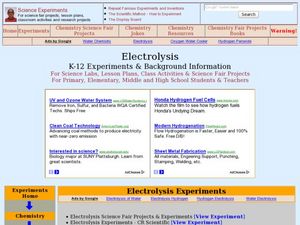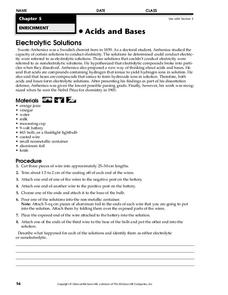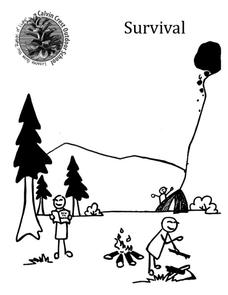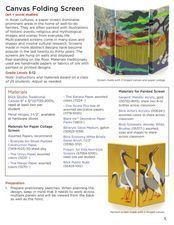Curated OER
More Chemical Bonding
In this chemical bonding worksheet, students review the three types of bonds including ionic, covalent and polyatomic compounds. They identify 8 compounds as ionic, covalent or polyatomic and they make 4 ionic compounds and they draw 5...
Curated OER
Electrolysis
Students conduct a series of experiments on water electrolysis. In this chemistry lesson, students explain what happens to the molecules during the process. They cite real world applications of electrolysis.
Curated OER
Mineral Identification
In this mineral identification lesson plan, students analyze 14 minerals and test their physical properties. They test the color, luster, streak, hardness and breakage of each mineral. Students answer 5 questions about the physical...
Curated OER
The Halogens
In this chemistry worksheet, students answer 24 questions related to properties of halogens. They fill in the table with the correct answers and participate in teacher demo.
Curated OER
What do Atoms Look Like?
In this atom worksheet, learners answer 31 multiple choice questions about the structure of atoms, the periodic table, the reactivity of elements, orbital diagrams and the families of elements.
Curated OER
IPC Chemistry Review
In this chemistry review worksheet, students classify and name compounds, calculate atomic mass, draw Lewis Dot Diagrams, and determine number of protons for atoms. This worksheet has 37 fill in the blank, 38 matching, and 3 short answer...
Curated OER
Minerals and Rock Cycle Review
In this minerals and rocks worksheet, learners answer questions about the chemistry of minerals, scratch tests, rocks and the rock cycle, and erosion and deposition.
Curated OER
Analyzing Oxidation-Reduction Reactions
In this oxidation-reduction reactions worksheet, students read about reactions where elements gain and lose electrons. When elements gain electrons they are reduced and when the lose electrons the elements are oxidized. They are given...
Curated OER
Writing Half Reactions
In this half reactions worksheet, high schoolers read about redox reactions and learn how to write half reactions showing the oxidized part of the reaction and the reduced part of the reaction. Students are given 10 redox reactions and...
Curated OER
Charge and Electricity
In this electricity activity, students read about electric charge, ionic notation, and conductors and insulators. Then students complete 19 matching, 6 fill in the blank, and 2 short answer questions.
Curated OER
Naming and Covalent Compounds
In this compounds activity, students practice naming compounds and classifying them as ionic, covalent, or polyatomic compounds. This activity has 12 fill in the blank and 12 problems to solve.
Curated OER
Naming and Covalent Compounds
For this naming and covalent compounds worksheet, students name 12 compounds using a chart of polyatomic ions if needed. They also draw covalent bonds in 6 compounds and answer 6 questions about ionic bonds, covalent bonds and polyatomic...
Curated OER
WHAT'S ORGANIC?
Students explore how certain foods come to be certified "organic." They write the words "organic" and "synthetic" and given the definitions of each. Students are given dictionaries. They are asked: "What is organic food?" Students grow...
Curated OER
Acids and Bases
In this acids and bases learning exercise, learners conduct an experiment to determine if solutions are electrolytic or nonelectrolytic. After completing the experiment, students answer 1 short answer question.
Curated OER
Edible Atom/Molecule
Upcoming chemists construct atom or molecule models out of candy. This is a classic idea that learners really enjoy; however, this lesson plan is vague. There is no instruction about the structure of atoms or molecules. Make sure you...
Calvin Crest Outdoor School
Survival
Equip young campers with important survival knowledge with a set of engaging lessons. Teammates work together to complete three outdoor activities, which include building a shelter, starting a campfire, and finding directions in the...
Curated OER
Lesson #46: Bar Graphs and Line Graphs
In this bar graphs and line graphs learning exercise, students interpret bar graphs, line graphs, and box-and-whisker plots. They find the measures of central tendency. This three-page learning exercise contains notes,...
Curated OER
Magnificent Magnets
Learners identify the properties of a magnet. In this physics lesson, students explore the strength of the magnet by testing out how a magnet reacts to various materials. The various objects the learners test include paper clips, paper,...
Curated OER
Phineas Gage: Concept Analysis
Prepare for teaching Phineas Gage: A Gruesome but True Story About Brain Science with this written analysis of the book. The analysis includes a summary, considerations for teachers, project ideas, and a list of additional resources that...
Science Geek
Electrochemistry
Introduce redox reactions including how to identify and solve them. After reviewing the rules for assigning oxidation numbers, a presentation presents trends and vocabulary. Finally, it explains voltaic cells, electrolytic cells,...
Curated OER
Canvas Folding Screen
Elementary, middle, and high schoolers design canvas folding screens; much like the ones that are so prevalent in Asian homes. Be warned that this art lesson requires a lot of materials, so it will be expensive to implement. However, the...
Curated OER
# 12 Using Bottled Water as a Problem Solving Exercise in Chemical Identification
Students work in groups of two or three, groups are given four unidentified bottled waters in unmarked containers and the chemical characteristics taken from the label on the bottled waters. They devise and carry out a plan to match the...
Illustrative Mathematics
3-D Shape Sort
From the apple on your desk and the coffee cup in your hand, to the cabinets along the classroom wall, basic three-dimensional shapes are found everywhere in the world around us. Introduce young mathematicians to the these common figures...
National Institute of Open Schooling
Radioactive Pollution
Radioactive pollutants can enter the body through ingestion, inhalation, absorption, or injection. The last lesson in a series of 36 introduces pupils to radioactive pollution. They study its sources, both natural and man-made, its...
Other popular searches
- Non Metals
- Non Metals
- Metals Non Metals Metalloids
- Highly Reactive Non Metals
- Extraction Non Metals
- Smetals and Non Metals
- Highlyrecative Non Metals
- Metals Non Metals Medallions























